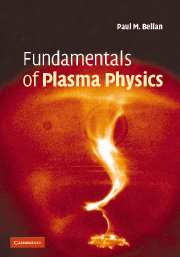Book contents
- Frontmatter
- Contents
- Preface
- 1 Basic concepts
- 2 The Vlasov, two-fluid, and MHD models of plasma dynamics
- 3 Motion of a single plasma particle
- 4 Elementary plasma waves
- 5 Streaming instabilities and the Landau problem
- 6 Cold plasma waves in a magnetized plasma
- 7 Waves in inhomogeneous plasmas and wave-energy relations
- 8 Vlasov theory of warm electrostatic waves in a magnetized plasma
- 9 MHD equilibria
- 10 Stability of static MHD equilibria
- 11 Magnetic helicity interpreted and Woltjer–Taylor relaxation
- 12 Magnetic reconnection
- 13 Fokker–Planck theory of collisions
- 14 Wave–particle nonlinearities
- 15 Wave–wave nonlinearities
- 16 Non-neutral plasmas
- 17 Dusty plasmas
- Appendices
- Bibliography and suggested reading
- References
- Index
9 - MHD equilibria
Published online by Cambridge University Press: 05 June 2012
- Frontmatter
- Contents
- Preface
- 1 Basic concepts
- 2 The Vlasov, two-fluid, and MHD models of plasma dynamics
- 3 Motion of a single plasma particle
- 4 Elementary plasma waves
- 5 Streaming instabilities and the Landau problem
- 6 Cold plasma waves in a magnetized plasma
- 7 Waves in inhomogeneous plasmas and wave-energy relations
- 8 Vlasov theory of warm electrostatic waves in a magnetized plasma
- 9 MHD equilibria
- 10 Stability of static MHD equilibria
- 11 Magnetic helicity interpreted and Woltjer–Taylor relaxation
- 12 Magnetic reconnection
- 13 Fokker–Planck theory of collisions
- 14 Wave–particle nonlinearities
- 15 Wave–wave nonlinearities
- 16 Non-neutral plasmas
- 17 Dusty plasmas
- Appendices
- Bibliography and suggested reading
- References
- Index
Summary
Why use MHD?
Of the three levels of plasma description – Vlasov, two-fluid, and MHD – Vlasov is the most accurate and MHD is the least accurate. So, why use MHD? The answer is that, because MHD is a more macroscopic point of view, it is more efficient to use MHD in situations where the greater detail and accuracy of the Vlasov or two-fluid models are unnecessary. MHD is particularly suitable for situations having complex geometry because it is very difficult to model such situations using the microscopically oriented Vlasov or two-fluid approaches and because geometrical complexities are often most important at the MHD level of description. The equilibrium and gross stability of three-dimensional, finite-extent plasma configurations are typically analyzed using MHD. Issues requiring a two-fluid or a Vlasov point of view can exist and be important, but these more subtle questions can be addressed after an approximate understanding has first been achieved using MHD. The MHD point of view is especially relevant to situations where magnetic forces are used to confine or accelerate plasmas or liquid conductors such as molten metals. Examples of such situations include magnetic fusion confinement plasmas, solar and astrophysical plasmas, planetary and stellar dynamos, arcs, and magnetoplasmadynamic thrusters. Although molten metals are not plasmas, they are described by MHD and, in fact, the MHD description is actually more appropriate and more accurate for molten metals than it is for plasmas.
- Type
- Chapter
- Information
- Fundamentals of Plasma Physics , pp. 305 - 341Publisher: Cambridge University PressPrint publication year: 2006
- 1
- Cited by



